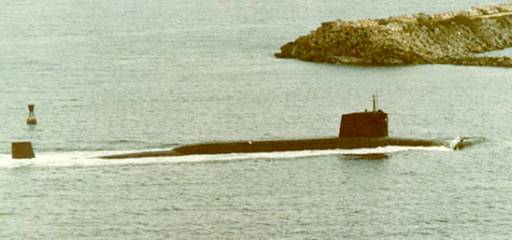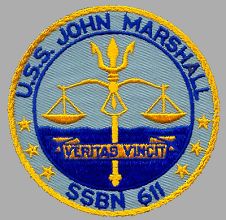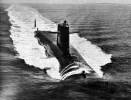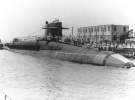

 |
Search the Site with

|
 |  |
USS JOHN MARSHALL was the fourth ETHAN ALLEN - class nuclear powered fleet ballistic missile submarine. After 19 years of service, the JOHN MARSHALL was redesignated as SSN 611 to comply with the SALT I treaty on May 1, 1981, and concrete blocks were placed in the missile tubes to disable the missile launch capability. The JOHN MARSHALL subsequently underwent conversion to an amphibious transport. This conversion allowed the JOHN MARSHALL to carry special forces. Modifications included additional troop berthing and removal of some missile tubes. The JOHN MARSHALL was finally decommissioned and stricken from the Navy list on July 22, 1992, and entered the Navy's Nuclear Powered Ship and Submarine Recycling Program at the Puget Sound Naval Shipyard, Bremerton, Wash. Recycling of the JOHN MARSHALL was finished on March 29, 1993.
| General Characteristics: | Awarded: July 1, 1959 |
| Keel laid: April 4, 1960 | |
| Launched: July 15, 1961 | |
| Commissioned: May 21, 1962 | |
| Decommissioned: July 22, 1992 | |
| Builder: Newport News Shipbuilding and Dry Dock Co., Newport News, Va. | |
| Propulsion system: one S5W nuclear reactor | |
| Propellers: one | |
| Length: 410.4 feet (125.1 meters) | |
| Beam: 33.1 feet (10.1 meters) | |
| Draft: 29.9 feet (9.1 meters) | |
| Displacement: approx. 7,900 tons submerged | |
| Speed: Surfaced: 15 knots, Submerged: 20 knots | |
| Armament: 16 vertical tubes for Polaris missiles, four 21" torpedo tubes | |
| Crew: 12 Officers and 128 Enlisted (two crews) |
Crew List:
This section contains the names of sailors who served aboard USS JOHN MARSHALL. It is no official listing but contains the names of sailors who submitted their information.
About the Submarine's Name:
John Marshall, Chief Justice of the United States and principal founder of American constitutional law, was born 24 September 1775 at Germantown (now Midland) in Fauquier County, Va. A member of the Culpeper minutemen early in the Revolution, he entered the 3rd Virginia Continental Regiment 30 July 1776 and served ably in a number of important campaigns, rising to Captain. He became a lawyer after the war, serving his state as a leader in the Assembly and in the new Federalist Party. He attracted attention from national leaders, and was offered several diplomatic posts, but preferred to remain in Virginia. In 1797, however, he accepted an appointment on a three man commission to negotiate with France. After French leaders demanded personal bribes in return for engaging in the negotiations, Marshall answered for his colleagues in a brilliant memorial which rejected this extortion and upheld the honor and dignity of the new country.
Elected to Congress in 1799, Marshall became Secretary of State 6 June 1800. Here he strongly opposed violations of American rights on the high seas and adopted a policy which necessitated a strong navy to give force to our diplomatic protests.
Appointed Chief Justice 20 January 1801, Marshall continued to serve as Secretary of State until the end of Adams' administration 4 March 1801. In the Supreme Court, Marshall made his greatest contributions to the development of American government. In a series of historic decisions, he established the judiciary as an independent and influential branch of the government equal to Congress and the Presidency. Perhaps the most significant of these cases was that of Marbury v. Madison, in which the principle of judicial review was simply stated by Marshall: "A legislative act contrary to the Constitution is not law." Then, as the young nation was endangered by regional and local interests which often threatened to tear it to shreds, Marshall again and again interpreted the Constitution broadly so that the Federal Government had the power to become a respected and creative force guiding and encouraging the nation's growth. For practical purposes, the Constitution in its most important aspects today is the Constitution as John Marshall interpreted it. As Chief Justice he embodied the majesty of the Judicial Branch of the government as fully as the President stood for the power of the Executive Branch. He died 6 July 1835, having served as Chief Justice for nearly 35 years.
USS JOHN MARSHALL Image Gallery:
 |  |
 Back to Ballistic Submarines list.
Back to Ballistic Submarines list.  Back to ships list.
Back to ships list.  Back to selection page.
Back to selection page.  Back to 1st page.
Back to 1st page.